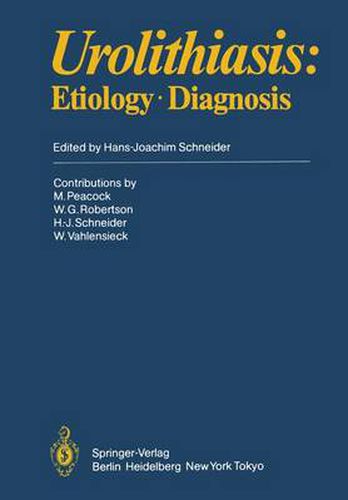Readings Newsletter
Become a Readings Member to make your shopping experience even easier.
Sign in or sign up for free!
You’re not far away from qualifying for FREE standard shipping within Australia
You’ve qualified for FREE standard shipping within Australia
The cart is loading…






This title is printed to order. This book may have been self-published. If so, we cannot guarantee the quality of the content. In the main most books will have gone through the editing process however some may not. We therefore suggest that you be aware of this before ordering this book. If in doubt check either the author or publisher’s details as we are unable to accept any returns unless they are faulty. Please contact us if you have any questions.
The handbook on lithiasis edited by Kurt Boshamer and originally brought out in 1961 was for more than two decades the standard work in this field for researchers and clinicians alike. However, our knowl edge of urolithiasis has been increased so enormously - by worldwide interdisciplinary research into the genesis of urinary calculi, by the new treatment possibilities opened up principally by advances in tech nology, and by the success achieved in prevention of recurrence - that it is almost impossible to take in all the relevant journal articles, books chapters, monographs, and proceedings. It was therefore our aim in this, the first of two independent vol umes, to provide a concise but comprehensive summary of current knowledge concerning the morphology and composition of calculi, epidemiology, pathogenesis, and diagnostic techniques. The most re cent developments are described, and nothing in the world literature is ignored. A second volume will cover medical therapy, operative, in strumental and noninvasive treatment, and prophylaxis. To have any chance of success, treatment and prophylaxis must be based on knowledge of calculus formation. Study of the composition of calculi has yielded important information regarding the conditions for formation, and this underlines once again the great value of analy sis of urinary concretions. Evaluation of epidemiological data has im portant consequences for the individual patient.
$9.00 standard shipping within Australia
FREE standard shipping within Australia for orders over $100.00
Express & International shipping calculated at checkout
This title is printed to order. This book may have been self-published. If so, we cannot guarantee the quality of the content. In the main most books will have gone through the editing process however some may not. We therefore suggest that you be aware of this before ordering this book. If in doubt check either the author or publisher’s details as we are unable to accept any returns unless they are faulty. Please contact us if you have any questions.
The handbook on lithiasis edited by Kurt Boshamer and originally brought out in 1961 was for more than two decades the standard work in this field for researchers and clinicians alike. However, our knowl edge of urolithiasis has been increased so enormously - by worldwide interdisciplinary research into the genesis of urinary calculi, by the new treatment possibilities opened up principally by advances in tech nology, and by the success achieved in prevention of recurrence - that it is almost impossible to take in all the relevant journal articles, books chapters, monographs, and proceedings. It was therefore our aim in this, the first of two independent vol umes, to provide a concise but comprehensive summary of current knowledge concerning the morphology and composition of calculi, epidemiology, pathogenesis, and diagnostic techniques. The most re cent developments are described, and nothing in the world literature is ignored. A second volume will cover medical therapy, operative, in strumental and noninvasive treatment, and prophylaxis. To have any chance of success, treatment and prophylaxis must be based on knowledge of calculus formation. Study of the composition of calculi has yielded important information regarding the conditions for formation, and this underlines once again the great value of analy sis of urinary concretions. Evaluation of epidemiological data has im portant consequences for the individual patient.